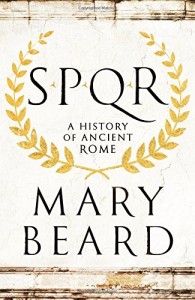 Published by Profile Books 20 October 2015
Published by Profile Books 20 October 2015
608pp, hardback, £25.00
Reviewed by Alison Burns
What do we think of first, when we think of the Romans? Aqueducts, amphitheatres? Legions, laws? Gladiators? Latin quotations?
Scholar Mary Beard suggests that we think of the Romans mostly as thugs, especially in comparison with the Greeks. The message of her weighty new history is that this is a gross simplification: ‘Since the Renaissance at least, many of our most fundamental assumptions about power, citizenship, responsibility, political violence, empire, luxury and beauty have been formed, and tested, in dialogue with the Romans and their writing.’
Take citizenship. In decreeing in 212 CE that all the free inhabitants of the Roman Empire, from Scotland to Syria, were Roman citizens, the emperor Caracalla completed a process that in Roman myth Romulus had started a thousand years earlier. ‘Rome’s founding father had been able to establish his new city only by offering citizenship to all comers, by turning foreigners into Romans.’
Or dissidence. We cannot read first-hand the views of provincial dissidents of the empire, but Roman writers could well imagine what it was like to be one. Famously, during his account of the conquest of Britain, the historian Tacitus has one local chieftain expressing what many must have felt: ‘Plunder, butchery, theft – they call it empire. They create desolation and call it peace.’ As Beard says: ‘No one has ever framed a better critique of Roman power than the words put into the mouths of rebels against Rome by Roman writers themselves.’
Beard takes us through the stages of Rome’s growth, from the stories of Romulus and Remus through the era of the Tarquins to the rise and fall of both Republican Rome and Rome under the emperors. One of the most interesting aspects of the early history is her emphasis on Rome’s small-town beginnings, in relation to which Rome’s eventual imperial reach is all the more astounding. And, although I would have liked a little more on quite how the infrastructure was designed, funded and maintained, we do see the expansion of Rome’s military might, upon which everything else depended.
It is a feature of this branch of ancient history that we do not see as much of the common man as we might like. For all the charm of glimpses caught in sites such as Pompeii and Herculaneum or Vindolanda on Hadrian’s Wall, we still see Rome largely through the self-revelation of the elite – in their letters and poetry, especially. It may be that, along with Roman roads and the stories memorialized in the histories of the time, and in Western literature ever after, the real legacy of Rome, if we seek to know it in a nutshell, lies in the language they used to think about life in a world they were dominating – and having to organize – from scratch.
